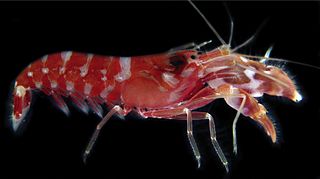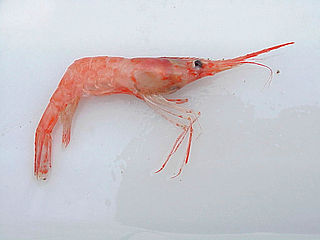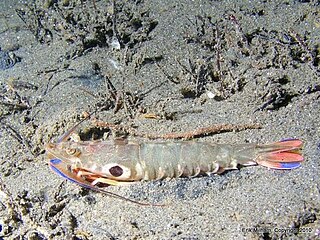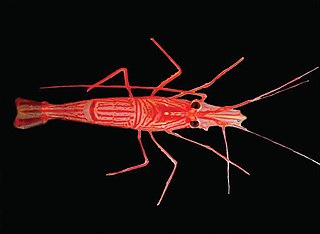
The Stenopodidea or boxer shrimps are a small group of decapod crustaceans. Often confused with Caridea shrimp or Dendrobranchiata prawns, they are neither, belonging to their own group.

The family Polychelidae contains thirty-eight extant species of blind, benthic lobster-like crustaceans. They are found throughout the world's tropical, sub-tropical and temperate oceans, including the Mediterranean Sea and the Irish Sea.

Lysmata debelius is a species of cleaner shrimp indigenous to the Indo-Pacific. It is popular in the aquarium trade, where it is known as the fire shrimp, blood shrimp or scarlet cleaner shrimp.

Hippolyte is a genus of shrimp in the family Hippolytidae, containing the following species:

Palaemonidae is a family of shrimp in the order Decapoda. Many species are carnivores that eat small invertebrates, and can be found in any aquatic habitat except the deep sea. One significant genus is Macrobrachium, which contains commercially fished species. Others inhabit coral reefs, where they associate with certain invertebrates, such as sponges, cnidarians, mollusks, and echinoderms, as cleaner shrimps, parasites, or commensals. They generally feed on detritus, though some are carnivores and hunt tiny animals.

Lysmata is a genus of shrimp in the infraorder Caridea, the caridean shrimp. The genus belongs to the family Lysmatidae. Lysmata are popular ornamental shrimp in the marine aquarium trade for their bright color patterns, interesting behaviors, and ability to control certain aquarium pests such as sea anemones of the genus Aiptasia. They are known to command high prices on the pet market.

Alope is a genus of shrimp in the family Hippolytidae, comprising two species:

Alpheoidea is a superfamily of shrimp. Species of shrimp in the superfamily Alpheoidea are drag swimmers, as opposed to lift swimmers.

Pandalus is a genus of shrimp in the family Pandalidae. Members of the genus are medium-sized and live on or near the seabed. Some species are the subject of commercial fisheries and are caught by trawling. One species, Pandalus montagui, lives in association with the reef-building polychaete worm, Sabellaria spinulosa.

Sicyonia is a genus of prawns, placed in its own family, Sicyoniidae. It differs from other prawns in that the last three pairs of its pleopods are uniramous, rather than biramous as seen in all other prawns.

Spongicolidae is a family of glass sponge shrimps in the order Decapoda. There are about 8 genera and more than 40 described species in Spongicolidae.

Marsupenaeus is a monotypic genus of prawn. It contains a single species, Marsupenaeus japonicus, known as the kuruma shrimp, kuruma prawn, or Japanese tiger prawn. It occurs naturally in bays and seas of the Indo-West Pacific, but has also reached the Mediterranean Sea as a Lessepsian migrant. It is one of the largest species of prawns, and is accordingly one of the most economically important species in the family.
Lysmata bahia is a species of saltwater shrimp first classified as Lysmata wurdemanni. It is found in shallow waters of the Atlantic Ocean, and can be distinguished by its coloration pattern.

Lysmata pederseni is a species of saltwater shrimp first classified as Lysmata wurdemanni. It is found in shallow waters of the Atlantic Ocean, and can be distinguished by its coloration pattern and its association with tube sponges.

Lysmata ankeri is a species of saltwater shrimp first classified as Lysmata wurdemanni. It is found in shallow waters of the Atlantic Ocean, and can be distinguished by its coloration pattern.

Thoridae, also known as broken-back shrimp or anemone shrimp, is a family of cleaner shrimp.
Leptochela is a genus of small shrimp from the family Pasiphaeidae. They are found in the Indo-Pacific region and the western Atlantic with an isolated species in Hawaii, they are absent from the eastern Atlantic Ocean and were absent from the eastern Pacific but specimens of a species widespread in the western Atlantic were collected from waters to the south of the tip of Baja California. Two species, Leptochela aculeocaudata and Leptochela pugnax have invaded the eastern Mediterranean from the Red Sea through the Suez Canal and are thus classified as Lessepsian migrants.

Periclimenes, commonly known as glass shrimp or cleaner shrimp, is a commensal and often symbiotic genus of semi-transparent shrimp within the family Palaemonidae. Species of this large genus feature a wide variety of coloration and patterns, widespread distribution throughout much of the world's tropical oceans, and are often sought out for aquarium trade.
Atyoida is a genus of freshwater shrimp in the family Atyidae. There are four species in the genus, each endemic to a different island group. The type species, Atyoida bisulcata, is endemic to Hawaiʻi and described by John Witt Randall in 1840.
















